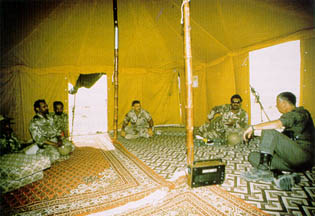 |
|
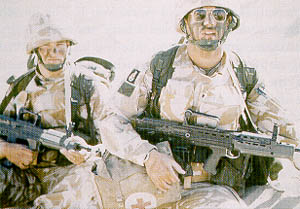
Coalition partners. American and Saudi (top), British (above), and French (right) allies work and train as members of the multinational coalition. |
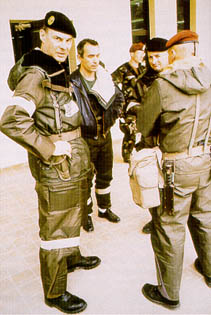 |
Inevitably, the plan that emerged from Army Central Command reflected the personality of its commander. Quiet and self-effacing, General Yeosock saw himself as not only a provider and allocator of resources but also a buffer between the corps commanders in the field and the flamboyant, often impatient Schwarzkopf. He set only general objectives for his subordinate commanders, allowing them to respond to the changing imperatives of the battlefield at discretion.1
To carry out the flanking movement, Army Central Command would have, in effect, both the light XVIII Airborne Corps and the heavy VII Corps. For a time, XVIII Corps included the 1st Cavalry Division (Armored), but in early January General Yeosock put this unit in theater reserve and moved the French 6th Light Armored Division out to XVIII Corps' left flank. The VII Corps, which arrived wearing the dark green woodland uniforms designed for combat in Europe, had perhaps the greatest concentration of armor and firepower ever assembled under a corps headquarters. By the time of the ground offensive
130
its collective strength became even more imposing with the addition of the British 1st Armored Division to its forces.2
Internal command and control problems were fairly straightforward compared to the confusing lines of authority between Central Command and other coalition partners. During the first months of DESERT SHIELD the coalition worked under an informal arrangement, whereby General Schwarzkopf led the Americans; General Mohammed Saleh Al Hammad, chief of the Royal Saudi General Staff, directed the Saudis, Egyptians, and Moroccans; and the leaders of the other national forces reported directly to their respective governments. When it came to issues of common interest, the coalition commanders conferred with each other. Such an amorphous relationship led to calls for a more formal command structure, perhaps a political committee and a council of military commanders, but no formal combined organization ever emerged. In accord with NATO practice, the British government placed its force under Schwarzkopf, except in matters of grand strategy and policy, and the French later followed suit. By the time of the ground offensive the coalition had effectively evolved into two combined commands-the Western allies under General Schwarzkopf, and the Arab members now under His Royal Highness Lt. Gen. Prince Khalid ibn Sultan, commander of the Joint Forces. In practice, the Arabs followed CENTCOM's lead, but without formally ceding authority to Schwarzkopf. Although inconsistent with the unity-of-command principle, the structure was probably the best available given the linguistic, cultural, and doctrinal differences between Westerners and Arabs.
Considerable coordination and the professional dedication of the senior officers who were involved made the coalition arrangement work.
131
At the top of the hierarchy Schwarzkopf, General Khalid, and the commanders of the British and French contingents, Air Chief Marshal Sir Patrick Hine and Lt. Gen. Michel Roquejeoffre, met regularly each day. In addition, Saudis under Khalid and Americans under Maj. Gen. Paul R. Schwartz addressed issues of mutual interest in the Coalition Coordination Communication Integration Center. Schwartz, who had previously served in Saudi Arabia and was Yeosock's deputy, ran the center, which provided a model for inexperienced Saudi staff officers, gave American planners easier access to the Saudi command system, and permitted combined staffing on such matters as acquisition of training areas and the host nation support program. With CENTCOM and Saudi General Staff headquarters located in adjacent facilities in Riyadh, substantial coordination also took place between American and Saudi staff officers on a daily basis. In the field the Army Central Command, the V11 and XVIII Airborne Corps, and the 5th Special Forces Group (Airborne), 1st Special Forces, stationed liaison teams with Arab units, reaching down in some cases below the brigade level. Other ARCENT and corps liaison officers served with the British and French allies.4
Not surprisingly, the Americans found it easier to work with the British and French, with whom they shared a European defense tradition. Normally part of the British Army of the Rhine, the British 1st Armored Division drew on its own history in desert warfare operations, carried out in North Africa by the famed "Desert Rats" of World War 11. The French 6th Light Armored Division, which resembled a large armored cavalry regiment more than a truly integrated division, likewise had substantial desert expertise. Among its 10,000 men were elements of the renowned Foreign Legion, perhaps the best desert-trained troops on the allied side, and several formations that had seen combat against Libyan forces in Chad. Despite differences in equipment, organization, and doctrine, the French division worked well with the XVIII Airborne Corps, with which it shared the role of a highly mobile rapid deployment force.5
The Arab forces varied in size and quality. The 40,000-man Egyptian contingent looked the best. The Egyptian 4th Armored and 3d Mechanized Divisions had experienced, well-trained, disciplined troops under senior officers, many of whom had served as battalion commanders in the 1973 war with Israel; were equipped with American materiel; and had participated with Americans in multinational exercises. The Saudis also used American equipment, but any similarity to the Egyptians ended there. The Saudi army, consisting of the relatively well financed Saudi Arabian National Guard and the Royal Saudi Land Forces, lacked manpower, experienced leadership, training, logistical support, and expertise in large-unit operations. What remained of the Kuwaiti Army also lacked training and, as a consequence of the invasion, equipment. The 10,000 troops from Bahrain, Qatar, Oman, and the United Arab Emirates were in need of equipment too. On the other hand, their level of training surpassed that of the Saudis and Kuwaitis.
132
 |
|

Coalition partners. American and Saudi (top), British (above), and French (right) allies work and train as members of the multinational coalition. |
 |
133
Of the other coalition partners, Morocco, Pakistan, and Bangladesh provided relatively small but well-trained forces, each with experience in counterinsurgency; Afghanistan, 300 Mujahadeen to serve as military police; and Senegal, 500 soldiers, who impressed American observers with their daily 90-minute sessions of physical conditioning. Syria's force of 15,000 represented the least-known quantity. No one knew how the Syrians would perform, but the memory of their defeat by the Israelis in the Bika Valley in 1982 was not encouraging.6
With such a mosaic of national forces, misunderstandings did occur. Schwarzkopf and Yeosock needed all of their considerable skills as diplomats to resolve conflicts. As a former project manager for the effort to modernize the Saudi Arabian National Guard, Yeosock was sensitive to Arab pride and the slow, complex ways of the Saudi bureaucracy-especially the fact that the royal family made all of the important decisions. Saudi staff officers wanted to be part of the planning process, yet the need to turn to higher authority often left them out of the chain. Not all problems were overcome. At the end of December Syria declined to take part in any offensive, and ARCENT planners had to promise more breaching equipment and the support of the 1st Cavalry Division to the anxious Egyptians. On the eve of the ground war Syria changed its mind, but its units were assigned only rear-echelon duty, in part because their Soviet-made equipment too closely resembled that of the Iraqis.
Even with the British and French, problems arose. Eager to be part of the main drive, the British pushed for and received a transfer from the U.S. Marines to Vll Corps, thus causing CENTCOM planners to reassign the Tiger Brigade to provide better armor support for the Marines. Coordination with the French was sometimes strained since they, like the Saudis, needed to refer any matter of consequence to their political leaders for decision. Considering the coalition command structure and the potential for disagreement, however, serious conflicts were few in number.7
By February Iraq had an army of more than 1 million men-about 950,000 regulars, of which some 480,000 were reserve and new conscripts, and about 90,000 volunteers. The regulars were organized into
134
seven corps and the volunteers into the corps-size Republican Guard Forces Command, the offensive component of Iraq's military. Three corps were deployed northward, partly facing the borders of Turkey, Syria, and Iran. The remaining four corps and the Republican Guard Forces Command were in southern Iraq, in Kuwait, and along the eastern part of the Iraqi-Saudi Arabian border and thus were of immediate interest to Central Command.
The corps was the principal controlling headquarters in the Iraqi field forces. Each corps commander controlled a variety of combat support and combat service support units: air defense, reconnaissance, engineer, chemical defense, medical, aviation, antitank, signal, electronic warfare, and special forces battalions. Of these elements, coalition commanders paid the most attention to artillery, air defense artillery, and rocket brigades. Each artillery brigade nominally had seventy-two weapons, and in some sectors brigades had twice that many. These mortars, howitzers, and guns generally reflected the Soviet inventory and included at least six sizes, ranging from 100 mm. to 160 mm. One type of Iraqi towed artillery, the South African G-5, with a range of 25 miles, particularly concerned allied ground commanders.
Each rocket brigade probably had eighteen transporter-erector launchers able to launch one of two major weapon systems: Soviet-made FROG (free rocket over ground) rockets, and three types of Scud intermediate-range ballistic missiles. The designation Scud was the NATO code name for the Soviet-designed SS-1 missile and its variants, which the Iraqis had bought from the Soviets and North Koreans during the war with Iran and modified to extend the range. With clearance from the General Headquarters, corps commanders could use the Soviet Scud-B or either of the two Iraqi-modified Scuds, the Al-Hussein and the Al-Abbas, with ranges between 200 and 400 miles.
Iraq's missile inventory represented a two-pronged threat to the effort to liberate Kuwait. On the strategic level the Scuds menaced the integrity of the allied coalition. Capable of reaching Israel, the Scuds could provoke a counterattack by the Jewish state, the archenemy of many of the Muslim countries that had deployed military contingents against Iraq. Such a development would almost certainly fragment the coalition. On the tactical level the missiles, as well as a variety of artillery pieces and aircraft, could be used to unleash a threat of great concern to coalition field commanders and governments alike: chemical attack.
During the seven months of the crisis, the Iraqi Army had between fifty-five and sixty divisions, the number fluctuating with draft calls, training cycles, and attrition rates. The Iraqis fielded several types of divisions: armored, mechanized, and motorized infantry. Each was nominally organized into three maneuver brigades, divisional artillery, and various combat support and combat service support units. A typical armored division had two armored brigades and one mechanized brigade; a mechanized division had two mechanized brigades and one armored brigade; and a motorized infantry division had three infantry brigades and one
135
tank battalion. After extended deployment, however, many divisions evolved to meet specific situations, expanding to include as many as eight maneuver brigades of any type, depending on the perceived threat in a particular sector. The large numbers of tracked and armored vehicles in Iraqi divisions-4,500 main battle tanks and 27880 armored personnel carriers all told-indicated impressive battlefield mobility and offensive potential. This armored capability was strengthened by the direct support of some 3,300 artillery pieces in the Kuwaiti theater of operations.8
The Republican Guard was the best of the Iraqi ground forces. During the Iran-lraq war this organization had been expanded from a Palace Guard of one brigade into a separate force-the Republican Guard Forces Command-of thirty to thirty-three brigades in seven divisions and had been the key to the victory over Iran in the final battles. The Republican Guard Forces Command possessed advantages of personnel and equipment over the larger Regular Army. All Republican Guard troops were highly motivated volunteers rather than conscripts; all had more training than the regulars; and all had the most modern equipment in the Iraqi inventory, including the Soviet T-72 M1 tank with night vision capability. This elite corps included infantry, mechanized and motorized infantry, and armored divisions.9
The Republican Guard Forces Command was divided into two subcorps groups, an independent division, twenty special forces (commando) brigades, and one naval infantry brigade. The heroic names of some of the subordinate elements underscored their elite character. The 1st Subcorps Group, deployed in southern Iraq and northern Kuwait, consisted of two armored units, the Hammurabi and Madina Divisions; one mechanized infantry unit, the Tawakalua Division; and a motorized infantry unit the Al-Faw Division. The 2d Subcorps Group deployed south of Baghdad consisted of two motorized infantry units the Nebuchadnezzar and the Adnan Divisions. The independent mechanized infantry unit was the Baghdad Division, stationed in and around the Iraqi capital. In January 1991 the formation of five more Republican Guard divisions was announced all motorized infantry. The names of only three of them were known to Central Command: the Al-Abed AlMustafa, and Al-Nidala Divisions.10
By mid-February the Iraqis had forty-three divisions along their southeastern border and in Kuwait. These divisions were organized in the II, II, IV and Vll Corps of the Regular Army and in the Republican Guard. The Iraqi order of battle in the triborder area included thirty-one infantry four mechanized infantry and eight armored divisions arranged in distinct lines and masses. A nearly solid line of infantry divisions, stretching from the Persian Gulf across southern Kuwait and extending about 100 miles farther west into southern Iraq, faced coalition forces and the Saudi Arabian border. Behind the east end of this infantry line, in a defensive arc south and west of Kuwait City, stood two mechanized infantry and two armored divisions; behind the west end, another armored
136
division. This front line of Iraqi units totaled twenty-eight divisions, all Regular Army. A second tier of fifteen divisions, including the remaining armored and mechanized infantry divisions, deployed in a more dispersed pattern across northern Kuwait and southeastern Iraq. Twelve of those divisions, five of them armored, were Republican Guard units.11
Map 10 Iraqi Dispositions Mid-February 1991
137
of the Iraqi defenses, the logistical feasibility of the proposed move, and the roles of the two corps. They were concerned that allied forces might bog down trying to break through the obstacles, leaving them vulnerable to artillery and chemical weapons, which few seemed to doubt the Iraqis would use.
Factored into ARCENT planning were the environmental variables of weather and terrain. In Iraq, a large desert zone sprawled west and southwest of the Euphrates River. It was part of the Syrian Desert, which covered parts of Syria, Jordan, and Saudi Arabia as well. The alluvial plain, created by the Euphrates and Tigris Rivers, extended from north of Baghdad to the Persian Gulf. Intermittent lakes and marshlands, the sizes of which varied from year to year and season to season, dotted the plain, as did the wadies, which were sometimes obstacles but mostly good avenues of approach.
138
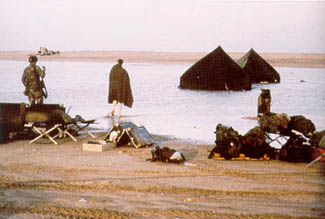
A tactical operations center flooded by torrential rains
The terrain and climatic features of the theater of operations presented tactical challenges that ground commanders and ARCENT planners could not ignore. The land surface of the desert zone was generally stony, with rare sandy stretches, and unusually level for great distances. While these conditions made cover and concealment very difficult, they invited rapid mechanized assaults, including armored strikes, and appeared to ease ground logistical support, since wheeled vehicles could apparently make their own roads in most places. In Kuwait itself, a gravelly and undulating land surface with intermittent sand dunes made defensive preparations easier and rapid assaults harder. The alluvial plain, with its many lakes and channels as well as the Euphrates and Tigris Rivers, offered barriers to mechanized movement. Marshlands would slow or prohibit ground operations if CENTCOM forces had to maneuver close to the Iranian border. The seasonal rain and sharqi-shamal phenomena threatened to slow, if not stop, ground operations by reducing vision and degrading base construction. And the wadies had to be taken into account to prevent their use as avenues of Iraqi attack.12
With so much of the terrain essentially featureless, ARCENT planners had to create objectives and draw phase lines that were not tied to prominent natural and man-made features. Although phase lines represented in graphic form a tactical concept rather than geometric purity, the lines for the offensive would show an unusually uniform ladder-like appearance as a result of the flat sameness of the desert. Corps and division commanders could establish supplemental phase lines within corps sectors as needed.
Logistics was probably the biggest problem. To preserve secrecy, Army Central Command could not move its troops and the required sixty days of supplies west of the triborder area until the start of the air war. Yet, once the air war began, the ARCENT staff estimated that it
139
would have only two weeks to deploy the vast numbers of soldiers and quantities of materiel before the start of the ground offensive, a formidable task in view of the limited number of roads and lack of vehicles to transport heavy equipment. To complicate matters, VII Corps would still be arriving in Saudi Arabia well after the start of the air war and would want time to acclimate and train its troops for their specific missions before moving them into position for the attack.
In October the Provisional Support Command established two forward logistical bases to provide critical medical, maintenance, fuel, and ammunition resupply services. The bases were huge, with perimeters as long as 80 miles. Within their boundaries, various units set up storage areas hundreds of yards apart. At an ammunition supply depot, numerous clusters of several dozen boxes were spaced far apart over many thousands of square yards. Combat service and combat service support units at those bases, such as hospitals, set up their operations and built low earthen hills around their borders. The first bases, code-named BASTOGNE and PULASKI, allowed the logisticians to clear the ports, stockpile vast quantities of materiel, and better plan their support of the spread-out XVIII Airborne Corps. Since it was becoming increasingly difficult to manage theater support operations from Dhahran, General Pagonis created the Northern Logistics Operations Center at King Khalid Military City in
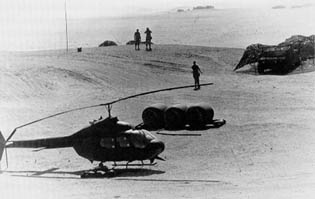
140
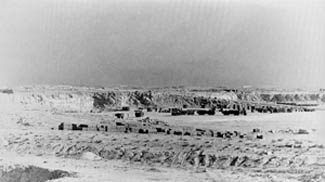
Ammunition supply depot near Dhahran, which was known as "The Quarry"
November. The move put him nearer to the action and facilitated support as more of the coalition forces moved forward. At the end of the month Pagonis established three more logistical bases-ALPHA, BRAVO, and DELTA-to support VII Corps and to provide a theater reserve.13
Also in November the Provisional Support Command began work on a comprehensive logistics plan. The objective was to support the arrival of VII Corps, to sustain the scheme of maneuver once hostilities started, and to provide for the redeployment of Army troops after the shooting stopped. General Pagonis and his staff contemplated a five-stage process, which they published in four command operations plans.14 To rehearse those plans, the staff and select subordinate elements participated in a two-day logistics exercise on 1-2 January 1991.
The first plan, Phase Alpha, involved the repositioning of Support Command units and theater-level stockage of supplies while receiving and moving the VII Corps to its tactical assembly area.15 The second plan consisted of two stages: Phase Bravo, the movement of the VII and XVIII Airborne Corps from their tactical assembly areas to their attack positions; and Phase Charlie, the support of the ground offensive into Kuwait and Iraq. All classes of supplies, but especially fuel, ammunition, food, and water, would be transported, based on the "90-mile rule"-delivering supplies up to 90 miles into Iraq for transfer to the corps-level support organizations. Two new logistical bases, designated OSCAR and NELLINGEN, would also be constructed deep inside Iraq to sustain the offensive if necessary.16 The last two plans focused on postwar operations. Phase Delta involved logistical support of civil-military efforts to restore services inside Kuwait once the coalition liberated that country. Phase Echo, designated Operation DESERT FAREWELL, envisioned the use of theater-wide assets to redeploy all U.S. Army units.17
As the theater matured, units from the United States continued to augment the logistical organization, which shed its provisional status and became the 22d Support Command as of 16 December. During the
141
month the 21st Theater Army Area Command, Augmentation, an Indiana reserve unit trained to reinforce a regular theater-level logistics unit in Europe, arrived and further reinforced the 22d's headquarters staff. A number of other reserve units, for example, the 800th Military Police Brigade and the 318th Transportation Agency (Movement Control), also deployed to the theater. Eventually, almost 60 percent of the 22d's personnel were reservists. In addition to the reserve units, such active-duty units as the 593d Support Group (Area) and the 89th Military Police Brigade served as subordinate components of the Support Command.18
THEATER STOCKAGE OBJECTIVES
| Class | Days of Supply |
|---|---|
| I (Rations) | 20 |
| II (Individual equipment) | 23 |
| IIIB (POL bulk) | 26 a |
| IIIP (POL package) | 23 |
| IV (Construction) | 23 |
| V (Ammunition) | 45 |
| VI (Sundry items) | 20 |
| VII (Major end items) | As needed |
| VII (Medical) | 0 |
| IX (Repair parts) b | As needed |
a Eighteen days host nation storage
b Selected major assemblies only
Source: Draft MS, John J. McGrath and Michael D. Krause, Theater Logistics
and the Gulf War (1992), p. 1.58.
With logistical operations spread over eastern Saudi Arabia, timely communications was critical to the coordinated delivery of supplies and equipment to the forward units. The 22d Support Command was fully aware that combat units could not move if fuel did not arrive on time. Many of its subordinate logistical units found that they were not authorized enough radios, which exacerbated the problem for the logisticians. Col. Daniel G. Brown, who replaced Col. David A. Whaley as commander of the 7th Transportation Group, had only three radios with which to coordinate the work of his command, which included 9,100 troops. One of his truck battalions had none.19 Col. Michael T. Gaw, commander of the 32d Transportation Group, fared no better. His headquarters deployed only the communications gear that was organic to his headquarters company
The, 22d's own logistical units faced similar communications equipment problems, but they were able to develop creative solutions. They took advantage of the modern civilian infrastructure of Saudi Arabia and used the telephone network extensively Pagonis' staff also contracted for cellular, vehicle-mounted phones to distribute to unit commanders. In addition, units used U.S. Air Force AM radios, mobile subscriber equipment, and satellite hookup phones to talk and send data over the long distances.20
The 22d Support Command also had responsibility for the weapon system replacement program, a theater-wide effort to prepare fully trained replacement crews for Abrams tanks, Bradley fighting vehicles, artillery pieces, helicopters, and light infantry squads. Those crews and their equipment would go to the forward combat elements as replacements for battle casualties. Although the 22d exercised command
142
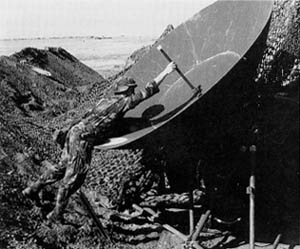
Signal troop adjusts a tactical satellite dish at a desert installation, consisting of the dish, two generators, and a shelter
responsibility for the program, the Seventh Army Training Center provided mobile training team support.21 General Pagonis considered that training among the most urgent aspects of his mission, and he closely monitored the effort.22 Hence, as the combat troops prepared for their move into the desert, the training teams readied a total of 116 tank crews, another 108 for Bradleys, 57 for a variety of artillery, and 27 light infantry squads to serve as battle replacements. Because the ground war was brief and casualties very light, the system was barely utilized and after the cease-fire the crews were among the first to return to their home stations.
The high operational readiness of the various pieces of combat equipment resulted from effective preventive maintenance by operators as well as materiel management. Leaders ensured that crews meticulously performed routine maintenance to keep their equipment combat ready. Infusions of new equipment throughout the entire campaign also helped keep the operational rates for Army equipment in theater remarkably high. In fact, the rates were better in most cases than for other Army units stationed in the United States. For example, those for key equipment, such as the MlA1 and the M2, during DESERT STORM were always above 90 percent, usually between 92 and 98 percent.23
Overseeing materiel management for General Pagonis' command was the 321st Support Center (Theater Army), a reserve unit, which arrived in Saudi Arabia in October. Its primary mission was to manage all classes of supply, especially Class IX, the spare parts for Army equipment. Yet prior to the 321st's arrival XVIII Airborne Corps already had its own centers working on materiel management, and thus several weeks passed before the 321st officially took over. Until then, the corps had to deal directly with Stateside agencies for spare parts. Eventually, theater-level control over repair parts was established. So long as the operational readiness rates of equipment remained high, Pagonis was reluctant to tamper with the arrangement.24 Overall, by January 1991, the 22d Support Command was well on its way to being able to support offensive ground operations.
143
posed plans that would enhance its role, such as a drive down the Euphrates River valley to cut Iraqi communications. It asked the addition of an armored division, preferably the return of the 1st Cavalry Division from theater reserve, to make such a maneuver possible.
From the start, however, CENTCOM and ARCENT planners intended to give the heavier VII Corps the primary task of destroying the Republican Guard. The main question regarding the XVIII Airborne Corps appeared to have been how that corps could support the VII Corps' mission. The planners were concerned that two corps operating in the same area would constrain each other's movements, and the VII Corps' desire that the XVIII Corps cover its right flank was rejected by ARCENT because it might leave the XVIII Corps in the kind of breaching role for which it was ill suited. So ARCENT planners put XVIII Corps in a screening role west of VII Corps and in position to support the latter.
From 27 to 30 December Army Central Command hosted a map exercise to review the draft plan and resolve differences between the VII and XVIII Corps. Through situational briefings, discussions within working groups, and general sessions to review those discussions, General Yeosock and his planners sought to anticipate every contingency. The exercise confirmed having the VII Corps in the lead role and keeping the 1st Cavalry Division in its capacity as theater reserve, but especially revealed the inherent problems in deploying the corps to their attack positions within two weeks of the start of the air war.
In response, ARCENT planners modified some of the riskier features. They moved the base of XVIII Airborne Corps' projected northward drive to the east, nearer to the VII Corps, and arranged to cut Highway 8, the key Iraqi line of retreat, with air power rather than ground forces. Although staffs revised details up to the eve of the ground offensive, the main elements were clear by February. A Marine amphibious force would demonstrate off the coast of Kuwait to divert Iraqi attention from the western flank. Near first light on G-day, Arab forces along the coast and Marines farther inland would attack the main Iraqi fortifications and fix the enemy's tactical and operational reserves. Meanwhile, the French 6th
144-145
Map 11 Preparing for the Ground War 17 January-17 February 1991
146
Light Armored Division and the 82d and 101st Airborne Divisions on the far left would attack north toward Baghdad and the Euphrates Valley, securing the coalition's left flank.
The main attack would come on the next day. The Vll Corps' enormous armored force, with the XVIII Corps' 24th Infantry Division (Mechanized) and the 3d Armored Cavalry on the left, would break through the enemy's fortifications, drive deep into the rear, and destroy the enemy's theater reserve, the Republican Guard. One hour after V11 Corps' attack, the Egyptians and other Arab forces on the right would attack into southwestern Kuwait to cover Vll Corps' right flank. Between the Arabs and the Vll Corps, in position to support the former, the 1st Cavalry Division would feint up the Wadi al Balin. Following Yeosock's leadership style, the plan only sketched the initial stages of the attack, leaving later moves to be determined by his corps commanders in response to events.25
Similar activities occupied Vll Corps. The 1st Infantry Division's engineer, Lt. Col. Stephen C. Hawkins, created two life-size models of Iraqi trenches for training in breaching techniques. The division experimented against these mock-ups and came up with a tactic that took advantage of the shifting desert sands and eliminated the need for troops to leave their armored vehicles to eject an entrenched enemy. The technique required plow-equipped tanks and armored combat earthmovers (ACEs) to turn along the trench lines after breaking through them. Then, while Bradley crews alongside poured cannon and machine-gun fire into the trenches, one tank or ACE moving along the front lip and the other along the rear filled in the trenches with their plows. If ever employed, this tactic could be expected to cause panic among the enemy while neutralizing his defensive works. 27
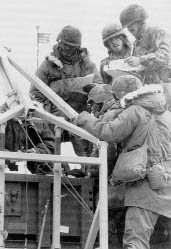
Soldiers Review MICLIC Manual Prior to Firing
Much of the training focused on the unique problems of desert warfare. Almost all of the Army's units had benefited from training at the Fort
147
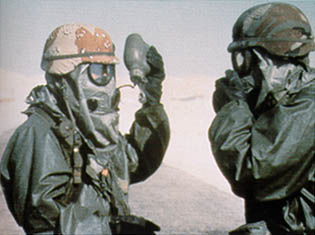
A Soldier in Full Chemical Protective Gear
Irwin National Training Center in California, and certain units, like the 24th Division, had stressed desert warfare in their own training programs. Still, the Saudi Arabian desert, with its lack of landmarks and its fine, abrasive sand, presented unique challenges. By November XVIII Airborne Corps soldiers had learned much about survival there, developing skills in land navigation, drinking copious amounts of water, working at night, and driving their vehicles abreast to avoid bogging down in each other's tracks. Using desert operations in World War II and the Arab-Israeli wars as case studies, they also learned to cope with the wide frontages, lack of concealment, dispersion, and emphasis on speed and maneuverability inherent in desert warfare.28
As American television viewers well knew, XVIII Airborne Corps spent a lot of training time on breaching operations. To create paths through minefields, tank ditches, and barbed wire, the corps worked with bulldozers, mine-rollers pushed by tanks, and portable bridges. They also practiced with the mine clearing line charge (MICLIC), a rocket-launched cable carrying a line of charges that, when fired across a minefield, exploded mines in its path. Training against the 82d Division's model of an Iraqi defensive system, one battalion matched each of its two assault companies with a bulldozer, MICLIC, and antitank platoon. The companies crossed the path created by these devices and attacked a triangular position at about the same time that friendly air and artillery fire shifted to supporting triangles.
After engineers opened holes in the sand berm wall with dynamite and plastic explosives, the two companies burst through the breach and fanned out into the trenches. Meanwhile, the battalion's third company maneuvered by the flank to block reinforcements from adjacent positions. In the end, these well-publicized exercises probably proved more valuable as decoys for the Iraqis than as preparation for the actual mission, but at the time no one could be sure of the 82d's eventual role.
Underlying much of the training was the concern that the Iraqis might use chemical weapons. They were known to possess mustard and nerve gas and had not hesitated to use chemicals against Iranian troops or rebellious Kurds. Outwardly, American military spokesmen minimized the threat, calling chemical weapons indecisive and relatively harmless with proper countermeasures. But the Army's logistical agencies rushed to meet the demand for protective gear and antidotes. The specter of American troops, unable to breach Iraqi lines and caught in a rain of chemical-laced artillery shells, haunted American generals.
148-149
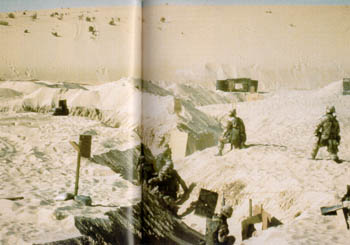
Even if losses could be minimized by prompt counteraction, it would be extremely difficult to operate in the hot, cumbersome protective suits, masks, gloves, and overshoes. To prepare for such an eventuality, XVIII Airborne Corps placed considerable emphasis on chemical warfare instruction, including detection, quick changes into protective suits, and use of antidotes. Like breaching training, the sight of American soldiers rushing to don gas masks became common on American television screens.29
The XVIII Corps' training priorities shifted to maneuver warfare and force modernization during December and early January. As modernization picked up speed, the corps devoted considerable time to live fire exercises to become familiar with new equipment. Shortages of training ammunition complicated such exercises, but by the start of the offensive practically every unit, except the air defense battalions, had tested its weapon systems. Often using live ammunition, corps troops worked on maneuver techniques, stressing the use of helicopters, concealment, and responses to different situations. Through exercises with the artillery and the Air Force, they improved coordination of fire support. At higher levels the corps used the Battle Command Training Program, designed at Fort Leavenworth, to hold seminars and exercises for instruction of staffs in command and control, a major concern of Lt. Gen. Gary E. Luck, the corps commander.30
The number of live fire exercises, along with concern in the United States over casualties among troops in the Persian Gulf, made safety a major concern for XVIII Airborne Corps. When the corps first arrived in the theater, it had had problems with helicopter crashes due to the pilots' inability to distinguish terrain features at night. In response, the Army had banned night flights below 150 feet for crews new to the desert, required every night helicopter mission to carry at least a three-soldier crew, and accelerated plans to put audio warning systems on altimeters. The problem had largely been solved by December, and other safety measures, such as careful marking of live fire ranges and surveillance of those ranges by helicopters, were implemented. By 22 February the death toll among American troops from noncombat causes had reached thirty, the majority from traffic accidents and freak gunshot incidents that occurred outside of training exercises.31
From the start of the campaign, training of allied forces had a high priority in Central Command. Although the Army had worked with Egyptians and Jordanians in past exercises, it had never trained with the Saudis or other Arabs in the coalition. Elements of the 5th Special Forces Group had deployed with the first American troops to arrive in Southwest Asia. By 1 December they had already instructed 13,000 allied troops in forty-three different subjects. Since the allied troops would rely on a largely American air force, communications and close air support received special emphasis, but the Green Berets also stressed weapons training and basic small-unit tactics, chemical countermeasures, and land navigation. As allied offensive plans developed, breaching operations came to dominate the training program.
151
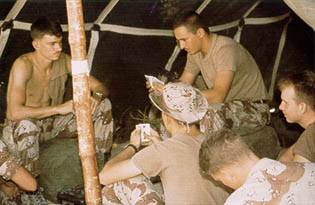
Soldiers Playing Cards in Their Tent
The XVIII Airborne Corps also became involved in combined training, instituting a partnership program that paired its units with Saudi formations from the Eastern Province Area Command. The 3d Armored Cavalry, for example, conducted live fire exercises with the Saudi 8th Brigade, and American engineers taught their Saudi counterparts breaching techniques. Since many Arabs spoke English and some Americans Arabic, language did not prove a major barrier, but at times cultural sensitivities made combined training a challenge for both sides.32
When not training, the troops of XVIII Airborne Corps made their life in the desert as comfortable as possible. Through December the corps stayed in practically the same position it had occupied since its arrival, backing up the Arabs along the Saudi Arabia-Kuwait border. The 3d Armored Cavalry held an advanced position near An Nu'ayriyah, with the 24th Division directly behind it at assembly areas HINESVILLE, MIDWAY, and COLUMBUS, and the 101st Division on its flanks at assembly areas CARENTON and EAGLE. Behind this line the 1st Cavalry Division had assembled at HORSE, and the 82d Division had deployed from CHAMPION MAIN, north of Dhahran, to FALCON BASE, near Abq Aiq. The troops also constructed living quarters from whatever lay handy, building houses and furniture from scrap lumber and cardboard. In the heat and dust, accompanied by clouds of flies, a cold drink of water, a fly swatter, and mail were a soldier's most valued commodities. The troops read, wrote letters, and played cards, volleyball, and football as they waited for whatever the future might bring. Looming over everything was the United Nations' 15 January deadline for Iraq to withdraw from Kuwait.33
Notes
1 Interv, David W. Hogan with Col Harold E. Holloway, 14 Jun 91, Fort McPherson, Ga.; Interv, Hogan with Maj Steve Holley, 21 Jun 91, Fort McPherson, Ga.; Swain interview; Draft MS, Swain, Operational Narrative, pp. 40, 43, 48, 55; Special Planning Cell chronology, p. 6.
2 Draft MS, Swain, Operational Narrative, pp. 65, 90-91, "Ground Planner Franks Knows War Horrors Well," Army Times, 4 Feb 91, p. 20; Jim Tice, "Seasoned Group Poised to Lead at Border," Army Times, 4 Feb 91, p. 39; Draft MS, Maj Alan T. Carver, How VII Corps Won the war, P. S.
3 CENTCOM Planning Cell interview, pp. 38-39; Holley interview; Holloway interview.
4 Department of the Army, Crisis Planning Team, Combined Command and Control Arrangements, 29 Oct 90, with Encls; Combined Operations Command Relations, 18 Aug 90, in JCS Policy Folder 1; Holley interview, Holloway interview; Eric Schmitt and Michael R. Gordon, "A Lot of Hurdles on the Way to Winning the War," New York Times, 24 Mar 91, p. 18, Memo, ARCENT G-3 Plans for DESERT STORM Study Group, 4 Jun 91, sub: OPLAN 1002, DESERT SHIELD and DESERT STORM Planning (hereafter cited as Memo for DESERT STORM Study Group); Draft MS, Swain, Operational Narrative, pp. 28, 87; MS, Doughty, War in the Persian Gulf, p. 3; Interv, Maj Robert K. Wright with Mal John S. Turner, XV111 Airborne Corps Liaison Officer to Eastern Province Area Command, 22 May 91, Fort Bragg, N.C., Special Planning Cell chronology, p. 13.
5 Sean D. Naylor, "New‘Desert Rats,’" Army Times, 22 Oct 90, p. 15; Holloway interview; Suzanne Lowry, "British Barbs Upset France's Soldiers," Daily Telegraph, 14 Dec 90, P. 10.
6 Sean D. Naylor, "Allies Under the Shield," Army Times, 22 Oct 90, p. 14; Holloway interview; Turner interview; MS, Doughty, War in the Persian Gulf, p. 4; Schmitt and Gordon, "A Lot of Hurdles on the Way to Winning the War," p. 18.
7 Schmitt and Gordon, "A Lot of Hurdles on the Way to Winning the War," p. 18; Margaret Roth, "Yeosock: Back in Familiar Territory with Shield," Army Times, 24 Sep 90, p. 91 Draft MS, Swain, Operational Narrative, pp. 25-26, 78, 88; Holloway interview; Turner interview; Steve Vogel, "U.S.-Egyptian Raid Silences Iraqi Artillery," Army Times, 25 Feb 91, p. 6; Interv, Maj Dennis P. Levin with Lt Col John R. Vines, 4th Battalion, 325th Airborne Infantry (2d/82d), 25 Jan 91, Rafha Airfield, Saudi Arabia; Special Planning Cell chronology, pp. 13, 15.
8 National Training Center Handbook 100-91, The Iraqi Army; Organization and Tactics [3 Jan 91] pp. 2-25; MS, Doughty, War in the Persian Gulf, p. 5.
9 National Training Center Handbook 100-91, The Iraqi Army; Organization and Tactics [3 Jan 91] pp. 25-32.
10 Richard Jupa and James Dingeman, "The Republican Guards: Loyal, Aggressive, Able," Army (March 1991): 54-62.
11 ODCSINT Intelligence Summary 400, 23 Feb 91.
12 Nyrop, ed., Iraq: A Country Study, pp. 69, 72, 75-76; Nyrop, ed., Area Handbook for the Persian Gulf States (Washington, D.C.: Government Printing Office, 1977), pp. 123-24; Safran, Saudi Arabia, pp. 206-07.
13 Interv, Maj William W. Epley with Col James W. Ireland, 1 Apr 91, Dhahran, Saudi Arabia; Draft MS, John J. McGrath and Michael D. Krause, Theater Logistics and the Gulf War [1992], p. 27.
14 Operations Plan 91-1, 12 November 1990, was the theater logistical plan for receiving VII Corps. Plan 91-2, 4 November 1990, was the logistical support plan for the reception, onward movement, and sustainment of U.S. forces. Plan 91-3 was for support of the Kuwaiti Task Force. Plan 9 1-4, 5 March 1991, concerned redeployment support. The dates and the numbering of the operations plans are out of sequence because the first two were published and then numbered later.
15 Maj William W. Epley, Notes of Lt Gen Pagonis' Briefing, 6 Mar 91, Dhahran, Saudi Arabia; Pagonis Briefing to Secretary of the Army Michael Stone, Apr 91, Dhahran, Saudi Arabia (videotape); Draft MS, McGrath and Krause, Theater Logistics, p. 158.
16 Pagonis Briefing to Secretary of the Army Stone, Apr 91.
17 22d Support Command (SupCom), Operations Plan 91-4, 4 Mar 91.
18 22d SupCom, DESERT SHIELD Command Rpt, 23 Mar 91, p. 8.
19 Epley Notes taken at 22d SupCom AAR, 1 Apr 91, Dhahran.
20 22d SupCom, DESERT STORM Command Rpt, 5 Apr 9 1.
21 Msg, ARCENT to SupCom, 17 Feb 91, sub: WSRO Operations.
22 SupCom Daily "sit down" Briefing Charts, Jan-Feb 9 1.
23 22d SupCom LogSitreps, 25 and 31 Jan, and 7, 20, and 25 Feb 91.
24 22d SupCom MMC AAR, 6 Apr 91; Epley Notes and Videotape of 22d SupCom AAR, 1 Apr 91.
25 Memo for DESERT STORM Study Group; Holloway interview; Holley interview; Special Planning Cell chronology, pp. 9-17; Draft MS, Swain, Operational Narrative, pp. 56-60, 71-74, 78-80, 90-91, CENTCOM Planning Cell interview, pp. 49-50, 56-61; Memo for COMUSARCENT, Attn: History Office, 25 Feb 91, sub: Training, Command Report Operation DESERT SHIELD; Swain interview; ARCENT Planning Slides, 8 Feb 91.
26 ARCENT Exercises and Training Command Rpt, 25 Feb 91; Memo for COMUSARCENT G-3, 12 Feb 91, sub: Training, Significant Historical Events, Operation DESERT SHIELD; Interv, David W. Hogan with Exercises and Training Section, ARCENT G-3, 14 Jun 91, Fort McPherson (hereafter cited as Exercises and Training Section interview); Vines interview; Interv, Maj Dennis P. Levin with Maj Walter Wilson, S-3, 1st Battalion, 504th Infantry (1st Brigade, 82d Airborne Division), 14 Jan 91, 82d Airborne Division Range Complex in Eastern Saudi Arabia; Dan Janutolo, "101st on the Front Lines," Soldiers 46 (January 1991): 16-19.
27 Washington Post, 13 Sep 91.
28 Trainers later acknowledged the value of literature from the Center for Army Lessons Learned in preparations for desert warfare. See Exercises and Training Section interview. See also Interv, Maj Dennis P. Levin with members of 2d Battalion, 319th Field Artillery (82d Airborne Division), 2 Feb 91, near Rafha, Saudi Arabia; Lee Ewing, "Tricks of the Trade," Army Times, 10 Dec 90, p. 30; Center for Army Lessons Learned, Winning in the Desert, pp. 7-12; Sean D. Naylor, "No Place to Hide," Army Times, 5 Nov 90, p. 14; Wallace Franz, "Army's Ability to Move Could Mean Desert Success," Army Times, 5 Nov 90, p. 29; Sean D. Naylor, "Sand Draws the Lines for Artillery in the Desert," Army Times, 26 Nov 90, p. 18.
29 Wilson interview; Vines interview; Caleb Baker, "Against the Wall," Army Times, 28 Jan 91, p. 24; Steve Vogel, "Burden of Breaching Iraqi Line Falls to Engineers," Army Times, 4 Feb 91, p. 15; Exercises and Training Section interview; Guy Gugliotta, "U.S. Experts Doubt Power of Poison Gas," Washington Post, 14 Dec 90, p. 45; "Chemical Weapons Not a Trump Card, Experts Say," Army Times, 1 Oct 90, p. 29; Philip Shenon, "Troops Who'll Counter Gas Attack: Ready or Not?," New York Times, 13 Dec 90, p. 20; J. Paul Scicchitano, "Pentagon Says Iraqi Chemical Threat Is Real," Army Times, 20 Aug 90, p. 16; Holley interview.
30 See XVIII Airborne Corps Sitreps for December and early January; Exercises and Training Section interview; Janutolo, " 101st on the Front Lines," pp. 16-19; Vines interview; ARCENT Exercises and Training Section Command Rpt, 25 Feb 91; Interv, Mal Dennis P. Levin with 2d Battalion, 159th Aviation (18th Aviation Brigade), 30 Dec 90, 18th Aviation Brigade Heliport near King Abdul Aziz Air Base.
31 J. Paul Scicchitano, "Clipped Wings: Army Hopes Copier Flight Restrictions Will Cut Accidents," Army Times, 22 Oct 90, p. 20; Exercises and Training Section interview; 2d Battalion, 159th Aviation, interview; "Two Soldiers Die in Accidents," Army Times, 14 Jan 91, p. 16.
32 See CENTCOM Sitrep for 6 Dec 90; see also CENTCOM and ARCENT Sitreps for Dec 90 and Jan 91; ARCENT Exercises and Training Command Rpts; Exercises and Training Section interview, "Armies Coordinate During Exercises," Army Times, 17 Dec 90, p. 60; Caleb Baker, "Saudi Soldiers Sense Urgency in Training," Army Times, 21 Jan 91, p. 20; Turner interview; Draft MS, Richard Stewart, Army Special Operations Forces in Operation DESERT STORM, pp. 2-5.
33 ARCENT Sitreps for Dec 90; William H. McMichael, "Playing the Waiting Game in Saudi," Soldiers 45 (December 1990): 13-17, Phil Prater, "First Team in the Desert," Soldiers 46 (February 1991): 13-16; Janutolo, "101st on the Front Lines," p. 16, Phil Prater, "Guarding Saudi Skies," Soldiers 46 (February 1991): 17; "Tanks and Men: Desert Storm from the Hatches," Army 41 (June 1991): 31; Vines interview.
page updated 7 June 2001
Return to the Table of Contents